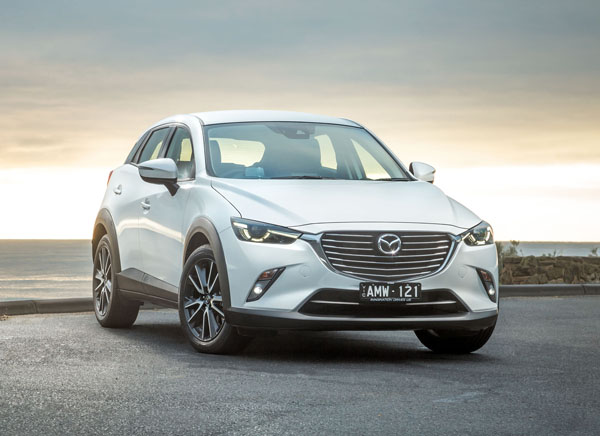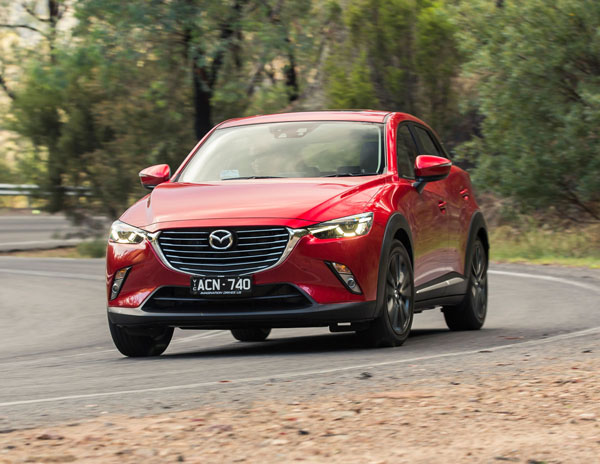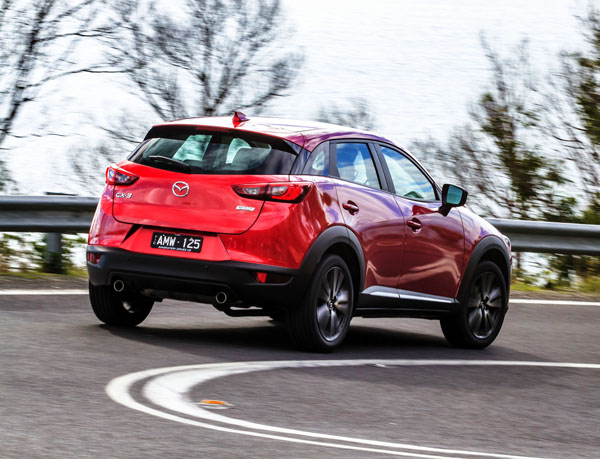
Sold in Australia since April 2015, the Mazda CX-3 was classed as an SUV but is better regarded as a sensible crossover between a hatchback and an SUV. It was immediately popular so even the oldest ones are now available in quite large numbers on the used car scene.
Styling is another major factor in the big sales numbers, with a continuation of the Mazda Kodo theme with its distinctive from and long bonnet.
The familiar Mazda model names of Neo and Maxx are used for the CX-3, but are joined by two new ones. The upper-middle CX-3 sTouring and topline Akari complete the range.
Inside the CX-3’s sensibly designed instrument is easy to use at a glance – a handy safety feature.
A head-up display, not on the topline models, shows vehicle speed and navigation directions.
Mazda CX-3 is unusual in offering both petrol or diesel power. The turbo-diesel is interesting in that it displaces just 1.5 litres and follows the latest European engineering trend of using small capacity, low friction engines aided by complex turbochargers for added power and torque.
Both 2WD (front wheels) and AWD CX-3s to Australia. This is increasingly unusual in this SUV class as many are now coming with drive only to two wheels. You wouldn’t plan to take one off-road, but the all-wheel-drive does offer added traction in slippery sealed road conditions. Some previous owners may have tackled mild off-road areas such as forestry trails. If you suspect this is the case it might be wise to pass up on these.
Six-speed manual or automatic transmissions are offered, but the manual only comes with the front-wheel-drive petrol-engine combination.
Mazda CX-3’s offers a fair amount of space in the back seat, though children rather than adults will be the more comfortable. Keep in mind this is a smallish SUV and something has to be compromised.
Luggage space is quite good for a car of this size and the two-level-floor option is clever. But try for yourself if you’re going to be carrying bulky items – some of the largest baby strollers just won’t fit…
May 2017 was interesting in that Mazda added extra equipment, particularly in safety features, as well as extra insulation to reduce interior noise levels – but didn’t give it a facelift.
August 2018 did see some cosmetic work, with a new front grille and rear combination lamps. Inside, the cabin featured a redesigned centre console, including a padded armrest. Urethane foam with a high-damping quality was used in the front seat cushions to give improved ride comfort. Seat upholstery was changed to full leather on higher grades.
The 2.0-litre petrol engine, which had seen a range of technologies applied to improve fuel economy and promote quicker engine response. The turbo-diesel unit was now a 1.8-litre unit and has excellent torque within increase in fuel use.
Mazda was one of the first Japanese marques to be imported to Australia and has been a solid player here since the beginning – that is after people stopped saying, “Mazda, don’t the just make light bulbs?”
There’s a strong network of dealers, though as is generally the way the great majority are in the big cities and large country towns. We’ve heard of no real problems in getting uncommon spare parts from the more remote dealers as they are often shipped within a day or so.
The Mazda CX-3 generally falls into midrange categories with insurance companies and we haven’t seen big financial penalties on young and or drivers with a poor insurance record. Shop around if you like but be aware that a long history with the same insurer could benefit if you ever a marginal claim.
WHAT TO LOOK FOR
Sometime small family vehicles are bought by those on a tight budget and services may have been pushed down the priority list. So check the service books to make they are up to date.
All the more reason to have a full professional inspection of the CX-3 before signing on the dotted line.
Feel for serious lag from a diesel as this may indicate it has problems.
Similarly look for a sudden burst of smoke from the exhaust during your test drive if the engine has been idling for a while and you accelerate hard.
Manual gearboxes that are stiff in their changes and/or crunch of fast downshifts may have problems.
Automatics that are slow to change, overly slow when shifting, or change ratios when they shouldn’t should be regarded as suspicious.
Do the usual checks of the condition of the seats and carpet (don’t forget the boot for the latter) for signs of damage caused by bored kids or poor loading of cargo.
HOW MUCH?
Expect to pay from$9000 to $13,000 for a 2015 Mazda CX-3 Neo Safety; $11,000 to $16,000 for a 2015 Maxx Safety; $15,000 to $21,000 for a 2016 sTouring; $18,000 to $25,000 for a 2017 sTouring; $19,000 to $27,000 for a 2018 Akari FWD; and $22,000 to $31,000 for a 2018 Akari AWD.
CAR BUYING TIP
Small family hatches/SUVs are all the rage at the moment so there will be plenty of offer on the used scene. Take your time to find the best one for your needs.
RECALLS: To browse recalls on all vehicles go to the ACCC at: www.productsafety.gov.au/products/transport/cars/













